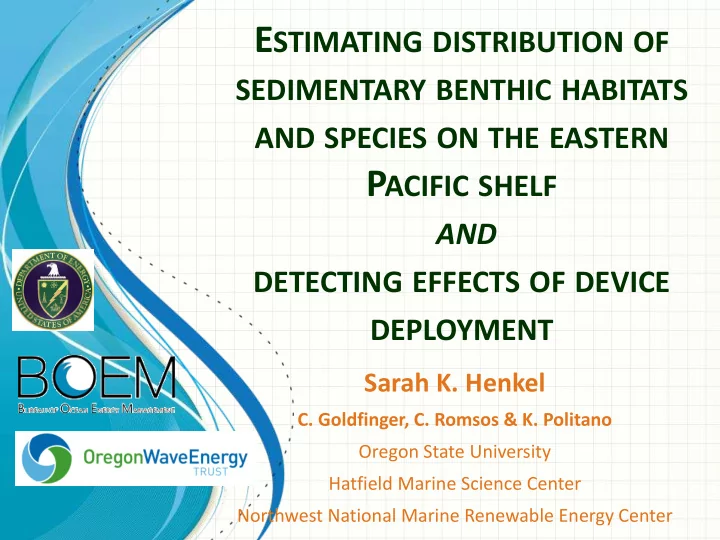

E STIMATING DISTRIBUTION OF SEDIMENTARY BENTHIC HABITATS AND SPECIES ON THE EASTERN P ACIFIC SHELF AND DETECTING EFFECTS OF DEVICE DEPLOYMENT Sarah K. Henkel C. Goldfinger, C. Romsos & K. Politano Oregon State University Hatfield Marine Science Center Northwest National Marine Renewable Energy Center
Regional Survey • High resolution mapping (5.5 sites) • Sediment ground-truthing (6 sites) • Invertebrate surveys • Infauna (box core): 8 sites, 153 grabs • Epifauna (ROV): 3 sites, 36 stations • Objectives: • Map habitat, not just geology • Develop predictive capabilities of where to find high priority habitat or species Part 1: Distribution of Habitats and Species
High Resolution Mapping Conducted by C. Goldfinger lab (OSU-CEOAS) Multi-beam sonar mapping (bathymetry) Acoustic backscatter (substrate type) Part 1: Distribution of Habitats and Species
Groundtruth with Grab Samples Conducted by C. Goldfinger lab (OSU-CEOAS) Part 1: Distribution of Habitats and Species
“Habitat” Maps based on Lithology Created by C. Goldfinger lab (OSU-CEOAS) Mean Grain Size Map: 3,360 samples selected from usSEABED, OSU, and BOEM databases; Inverse Distance Weighted Method: Error 8.15% % Sand Map: 3,455 samples from usSEABED, OSU, BOEM, and EPA; Inverse Distance Weighted Method: RMS Error = 14.03% Part 1: Distribution of Habitats and Species
Infauna and Sediment Sampling 0.1 m 2 Grey-O’Hare box core Water quality samples Sieve through 1.0 mm mesh Analyze sediment for grain size, fines, TOC, TN Identify infauna in the lab Part 1: Distribution of Habitats and Species
LINKTREE Analysis > 60 % gravel < 60 % gravel 2 gravel habitats: high & low 0 % gravel > 10 % gravel Muddy sand: pretty homogeneous Deep sand: rather homogeneous < 84 % sand > 87 % sand Shallow sand: high heterogeneity ‘Pure sand’ unique from 99 % sand < 81 m > 86 m < 81 m > 86 m Routine in PRIMER 6 – come talk to me if you want details
Subtle Differences in Sediment Composition Matter Species assemblages within the study zone primarily shaped by % sand. Secondary differentiation based on depth and grain size. Next steps: adjust bins to reflect species preferences rather than equal splitting: • 99 – 100 % sand 85 – 99 % sand • • < 84 % sand • 60 – 100 % gravel • 10 – 60 % gravel Part 1: Distribution of Habitats and Species
Pacific Marine Energy Center North Energy Test Site Ocean Sentinel TRIAXYS Wave Measuring Buoy Provide stand-alone electrical loading n WEC Under Test o i a t t s e r o h s o T and power conversion for test WEC Approximately 100 m Measure and record WEC power Ocean Sentinel Instrumentation Buoy Load bank output DAS & P Telemetry o U w Power e m r b Conversion & i l i f c i b a l e r o p t i c Collect and store data transmitted from the WEC under test and nearby wave-measuring instrument Transmit collected data to shore via wireless telemetry system Part 2: Detecting Device Effects
NETS Benthic Surveys Core Trawl Video ✔ May 2010 ✔ ✔ June 2010 ✔ ✔ ✔ August 2010 ✔ ✔ October 2010 ✔ ✔ February 2011 ✔ ✔ ✔ April/May 2011 ✔ ✔ ✔ June 2011 ✔ ✔ ✔ August 2011 ✔ ✔ ✔ October 2011 ✔ ✔ December 2011 Test Berth ✔ ✔ June 2012 Area ✔ ✔ ✔ Aug/Sept 2012 (1 nm 2 ) ✔ ✔ Oct/Nov 2012 ✔ April 2013 ✔ ✔ June 2013 ✔ ✔ ✔ Aug/Sept 2013 ✔ * ✔ ✔ October 2013 NEPA Analysis Area (6 nm 2 ) ✔ December 2013 ✔ February 2014 ✔ * April/May 2014 Today?
Infauna and Sediment Sampling Sediment Composition Stable: No Seasonal or Inter-annual Variation Infauna invertebrates: strong (but stable) spatial heterogeneity Part 2: Detecting Device Effects
2012 ROV Survey of Wet-NZ test Starting in 2013, anchor grabs Part 2: Detecting Device Effects
Shell Hash Proportion Data pooled for October 2013 and April 2014 p = 0.545 Part 2: Detecting Device Effects
Effects on Grain Size? Data pooled for October 2013 and April 2014 p = 0.067 Part 2: Detecting Device Effects
Effects on Organisms? 600.0 Total Infaunal Organisms 500.0 400.0 # organisms per 0.1 m 2 300.0 200.0 100.0 0.0 40 50 40 50 40 OSNE 50 40 OSNE OSNW 50 6/20/13 6/20/13 8/19/13 8/19/1310/24/1310/24/1310/24/134/18/14 4/18/14 4/18/14 4/18/14 Part 2: Detecting Device Effects
Summary Species assemblages offshore within the region primarily shaped by % sand and depth, finer differentiation based on grain size. North Energy Test Site mostly consists of 99 – 100% medium to coarse sand, little capacity for change due to scour Some evidence of shell hash accumulation and scour around anchors with potential reductions in infaunal abundances at the end of the summer Little evidence for anchor effects at the end of winter Stay tuned…anchors are staying in until August No detectable effects > ½ km away from installation
Acknowledgements Field and Lab Support (464 box cores) R/V Elakha Travel Support: Kristin Politano Annex IV Miss Linda U.S. DOE Chris Romsos R/V Pacific Storm PNNL Tim Lee R/V Derik M Baylis Andrea Copping Elizabeth Lopez Wil Black Collaborator: Nate Lewis Chris Goldfinger Stephanie Labou Danny Locket Bob Hairston-Porter Andrea Havron Jason Phillips
Part 2: Detecting Device Effects
Benthic Invertebrates – grabs 2010-14 @ NETS, 2013-14 @ SETS Groundfish (mostly flat) – trawls NETS 2010-14 @ NETS o Dungeness Crab – pots 2013-14 @ SETS Marine Birds and Mammals – ship- based observations Suryan, Klinck (2013-14 @ NETS & SETS) Acoustics (Haxel, Dziak) SETS 2011-13 @ NETS 2014 + @ SETS Electromagnetic Fields Schultz
Recommend
More recommend